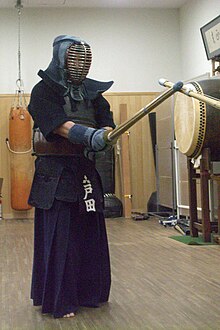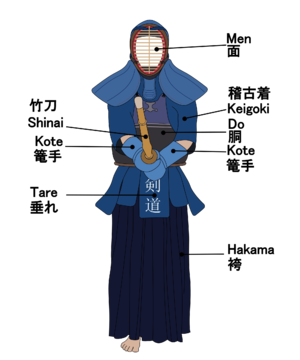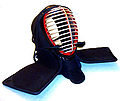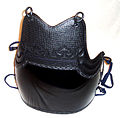Kendo
kendo [in Japanese, (剣道)] is a gendai budō, or modern Japanese martial art training that stands out for the use and management of the bamboo saber or shinai. The name means 'way of the saber'; and comes from the ideograms 剣 (ken, 'saber', 'sword') and 道 (dō, ' camino', 'path', 'via').
Kendo is considered the direct heir to several of the Japanese fencing schools known as ryū; being especially influenced by the Ono-ha Ittō-ryū school; In these schools or ryū, the legendary Japanese medieval warriors or samurai were trained in the classical art of saber fencing or kenjutsu.
In kendo, one faces the opponent wearing armor (bōgu) and a bamboo sword (or shinai); Likewise, as in all traditional martial arts, there are pre-established forms or kata, which are executed in pairs and with wooden sabers or (bokuto).
It is important to note that on some occasions, such as in exhibitions, the kata are executed with the real Japanese saber or (katana), and that kendo is the martial art and combat sport that has had the most influence, along with judo.; the methodological, pedagogical and terminological development of modern Japanese martial arts developed in the 20th century or gendai budō such as karate and aikidō; because several of the founding teachers and/or diffusers of these disciplines in Japan and in the West, practiced it as part of their martial training.
History, background and origins
Since ancient times, the samurai warriors of Japan have been trained through the practice of weapons with special attention to classical fencing or kenjutsu. Some exceptional warriors developed and codified their own style of swordsmanship, establishing training schools that continued for centuries, the basic form of which is still practiced today. The names of some of the schools reflect the philosophical essence of the founder. In this way, the Ono-ha Ittō-ryū (school of a single sword/cut) indicates the idea of its founder, the master Itō Ittōsai that all cuts with the saber emanate from and are contained in one essential original cut. Likewise, the variant Ittō Shōden Mutō-ryū (school without sword) expressed the understanding of its founder Yamaoka Tesshu, who said "There is no sword outside of the mind" it also expressed the understanding that the essence of fencing transcended the reflective thought process.
Following the Meiji Restoration at the end of the 19th century in 1896, traditional martial arts in Japan were reformed. Originating what we know today as the gendai budō or modern martial arts. In the case of fencing styles with classical saber or kenjutsu; these were transformed and codified in modern Kendo, preserving the formal exercises of the most representative schools of kenjutsu. Being studied nowadays using wooden sabers or (bokken) in the form of pre-established combat schemes or kata. In training and in sports combat or shiai the bamboo saber or (shinai) is used, hitting predetermined targets, protected by armor.
So today it is still possible to embark on the search for the spirituality of the samurai warrior of yesteryear. Concepts like the mushin or 'empty mind' Such vocal exponents of zen are the essence of achieving the highest levels in the art of kendo. Other concepts inherent to the practice, such as the fudoshin or 'impassive mind' are concepts attributed to the deity Fudo Myo-O (Acala), one of the five 'kings of light' in Shingon Buddhism, it implies that barriers cannot be swept away by the disappointment of anger, doubt, fear, or surprise presented by the opponent's actions.
In 1920, Dai Nihon Butokukai (大日本武徳会, promoter of the regulation of martial arts, after World War II) (1939-1945) changed the name of the classical swordsmanship known as: kenjutsu (剣術, saber technique) or gekiken (撃剣, striking saber) for the term kendo.
Graduations
The level of a kendo practitioner is measured, as in other modern formative martial arts or Gendai Budo, by the system (kyū-dan) as in the case of Karate-Do and Judo through graduations. In the case of kendo, there are six basic grades or kyū (sixth kyū being the lowest and first kyū being the highest) and eight grades. intermediate and advanced levels or dan, the first dan or shodan is the lowest and the highest that can be achieved through examinations is the eighth dan or hachidan. The 8th dan exam remains the most demanding of all exams in Japan, generally being passed by less than one percent of applicants (it is considered even more difficult than the state exam to become a lawyer, considered the toughest in the country).
While kyū degrees are displayed by means of colored belts in other traditional martial arts such as Karate-Do and Judo, and dan degrees by means of of the black belt, in kendo there are no visible signs that indicate the degree of the person. In his philosophy, graduation is not important: what is relevant is the kendo that the practitioner does and demonstrates. Obtaining basic or intermediate grades or kyū are regulated by national organizations, each country establishes the rules for obtaining them, higher grades or dan are regulated by the Federation International Kendo or FIK.
| Degree | Requirement | Required age |
|---|---|---|
| 1-dan | 1-kyū and 6 months of training | At least 13 years old. |
| 2-dan | At least 1 year of training after receiving 1-dan | |
| 3-dan | At least 2 years of training after receiving 2-dan | |
| 4-dan | At least 3 years of training after receiving 3-dan | |
| 5-dan | At least 4 years of training after receiving 4-dan | |
| 6-dan | At least 5 years of training after receiving 5-dan | |
| 7-dan | At least 6 years of training after receiving 6-dan | |
| 8-dan | At least 10 years of training after receiving 7-dan | At least 46 years old. |
Parts of the bōgu (armor)
- Men: Protector of the head and neck, lined and with a grid on the front side called men-gane to protect the face. The chin grill should never touch the dojo floor, it is considered a disrespect.
- Tenugüi: It is a handkerchief that is placed between the head and the men, its function is to dampen the blows a bit and collect the sweat from the head and the hair so that they do not enter the eyes.
- Kote: Hand protector and forearm. Optionally they can also wear fabric gloves before you put the kote, so the sweat does not spoil that part of the armor.
- Dō: Protector of the chest and abdomen. The upper part may be lined in leather or leather, and it is called mune. The lower part is called do-dai, formerly made of bamboo sheets covered in different leather types (from bandage to shark skin) which could have or not a layer of lacquer. You can also find do-dai synthetic materials (e.g. fiber).
- Tare: Pelvic part protector. It's a thick mandil composed of skirts.
The bogu is worn over clothing consisting of a thick cotton jacket (the kendōgi) and a pair of pants with wide pleats similar to a skirt or hakama. A loose scarf made of soft material (tenugui, often decorated with Japanese calligraphy and powerful symbols) worn under a helmet or men to absorb sweat and minimize chafing.
The armors or bogu are also called kendōgu, and vary according to their quality of shock absorption and price, depending on the number of millimeters that separate the seams (how many less millimeters, better). The price also varies depending on whether the manufacture of the bogu was artisanal or industrial. Regardless of the quality of the bogu, a practitioner should always be very attentive to its maintenance, hygiene, and general appearance.
One dons the armor as follows:
- The following manoeuvres are always performed in seiza
- Place the tare.
- Place the dō.
- Place the tenugüi and men.
- Place the kote Left first, then right.
You have to take into account that the himos (cords) when tying them must all be the same length.
Removing armor is done in reverse, starting with the right kote.
When packing the armor, keep in mind that:
- They shouldn't stay. Him (cords) loose or hanging from the package that forms the armor.
- The hollow parts of the armor should not be shown to the front.
- It must be well packaged, symbolizes a clean technique and respect for the opponent.
To store it, the tare (thigh and crotch protector) or the dō (abdomen protector) is spread on the mat or tatami, it is more correct to put the tare before, but the dō absorbs blows better and when placed like this prevents other parts of the bōgu, then it is put on top with the waist or neck part of the next piece that you have chosen to leave for later, if it is the tare or the dō, then the men (helmet) is inserted with the grid facing up and the tenugi (broad scarf) inside, then the kotes (or forearm protectors) inside the men, and finally the gloves inside the kotes, as well as wristbands that are worn in some cases to prevent injuries. All the himos must be well collected within their respective pieces.
Kendō as a competitive sport or shiai
The kendō is a method of training for combat with a bamboo saber or shinai.
The practice of kendō ranges from a purely sporting aspect (shiai), to the practice of traditional forms with the Japanese sword (Nihon Kendo Kata) that compile several of the techniques coming from the classical schools of kenjutsu, going through a marked development of the values of the person. All this makes it difficult to define, since it seeks to be something more than a traditional martial art (budō), and something more than a competitive sport. The kendōka (kendo practitioners) like to define it as a way of life. In addition to that his philosophy can be applied to face any type of adversity.
Learning the art of kendō
The total weight of the equipment is about 5 kilograms. During a training session, you lose as much water as you would on a hot summer day or a high-impact aerobic session. Kendo sparring and practice is actually a great cardiovascular workout even if you are not interested in participating in competitions.
Beginners always start training without armor. You begin by learning various movement techniques of the feet (ashi sabaki), of the body (Tai sabaki) and the main cuts or suburis, seeking to obtain complete control of the practice saber or Shinai, which must be mastered before it is time to put on the armor or bōgu and start striking hard at the opponent; subsequently all cuts are executed with full armor against an opponent. The few cutting techniques need to be practiced and refined over and over again following the kaisen or continuous improvement method found in all Japanese martial arts; among the various techniques and tactics there are: counterattacks, situation assessment techniques, rapid movement techniques, tactical displacement, feints, feints, etc. And the development of endurance and agility.
One of the principles of kendō is called "KI-KEN-TAI no ichi", which means that the spirit, (Ki) the sword (Ken) and the body (Tai) they have to act at the same time, the KI is demonstrated by shouting, the KIAI, the attack zone simultaneously with the blow, demonstrating the total involvement, physical and mental, in the attack
The shinai traditionally consists of four bamboo slats held together by leather straps and a leather handle. Nowadays there are also shinai made of graphite available, or even made of much more durable carbon fiber material, suitable for training purposes.
Name of the contact surfaces where the attack is allowed
- Men: Head. It consists of a vertical blow that hits the opponent's front with the shinai. The attack must be carried out with contundence and pretending that the weapon reaches at least half of the skull.
- Kote: Antebrazo. It is a matter of splitting one of the forearms with which the opponent holds the sword, it is allowed to attack both arms if the opponent has a high guard, and only the right if his guard is low.
- Dō: Abdomen. It is usually struck on the right side of the abdomen, as it is considered that traditionally on the left the opponent carries the saya (found of the swords) and could stop the coup in such a way that your sword was stuck or the wound inflicted was not fatal, although in combat it is allowed and it is punctuable to hit both sides. The sword enters diagonally through the abdomen by cutting from the liver to the navel.
- Tsuki: Garganta. It is a coup rarely used in combat because its execution requires great accuracy due to the sensitive area in which the stung is performed, for this reason it is usually not allowed in combat of practitioners with graduations less than the first dan.
Influences on other martial arts
Kendo has influenced all Japanese martial arts for centuries because the main weapon of the Japanese medieval warrior or samurai was his sword, and many of the founding masters of these disciplines were trained in Kendo. This influence is still noticeable in today's formative martial arts or gendai budō, such as aikidō, judo, ninjutsu, jiu-jitsu, and karate.
In judo several of the fundamental grips, and variations of these during throws are similar to the ways of gripping the bamboo sword or shinai in kendo. It is important to note that in judo, as well as in traditional jiu-jitsu, aikidō, and ninjutsu, preserve within their respective programs to the high degrees or dan, the tachi-dori techniques, designed to defend oneself from an attacker with a saber.
Regarding Japanese karate-dō, both its learning methodology and its traditional form of execution have been influenced by kendo. In the Japanese karate-dō shotokan style, the exercises in pairs or pre-established combat were adapted to 5, 3 and 1 steps, or Gohon, Sambon and Ippon kumite, in addition to the use of the saber hand, known as tegatana or shuto in blocks, checks, grabs and hits. Even the low height of some of the foot positions was adopted taking into account the katas of traditional Japanese fencing styles or kenjutsu, and the way power is transmitted in some blows. Since the son of the teacher Gichin Funakoshi, founder of the style, Yoshitaka Funakoshi practiced it, as well as his successor, the teacher Masatoshi Nakayama who in 1949 founded the well-known JKA or Japan Karate Association. It was they who incorporated several of the physical, technical, tactical and methodological principles of kendo into unarmed combat. That is why traditional Japanese Karate-Dō is considered a body fencing system. Even in today's sport karate, where a point is scored on a permitted contact zone, by a fist or foot gesture, with a legal contact surface (eg, instep or sole), the contestant must score and walk away. of the opponent similar to kendo. Likewise, in the first sports combats of karate-Do, parts of the Kendo armor were used, from which the current protections popularized by practitioners of Korean karate or taekwondo derive.
Likewise, Aikido derives part of its tactics and various techniques from some of the classic styles of saber fencing, or kenjutsu such as Onna-ha Itto Ryu kenjutsu and Yagyu Ryu kenjutsu. For this reason part of their displacements and various movements of some techniques that are also based on the trajectory of the cuts can still be seen in kendo and Iaido (art of drawing the saber and cutting in a single gesture) today.
In South Korea, the modern martial art of the Korean sword, or Kumdo, was influenced almost entirely by kendo (since Korea initially imported sword culture from Japan during the Kofun period, more precisely in the kingdom of Silla, and later during Japan's invasion of Korea that lasted 35 years, until the end of World War II in 1945) as well as various technical and tactical aspects and rituals, or ceremony. Although the forms or kata of kumdo are based on the martial arts from their own culture.
In the Philippines, the martial art of fencing with traditional weapons (whether sticks, daggers, knives and/or flexible weapons), called Eskrima / kali / arnis, has adapted part of the kendo armor to make its sport practice (combat with sticks) safer, and real by improving the degree of contact.
Similarly, several schools of non-traditional modern martial arts, that is, hybrids, have included combat with practice sabers made of flexible foam called "chambara", in order to perform choreographies or practice simulated combat while point, or adopting some Kendo techniques irregularly.
Kendo in Spain and Latin America
In Spain, the Royal Spanish Federation of Judo and Associated Sports was founded in 1965, with the following schools: - Almeria: Ishindenshin. - Asturias: Vetusta Kendo. - Barcelona: UPC Kendo Club, Renshinkan, Ryoshinkai. - Bilbao: Kendo Euskadi. - Canary Islands: Teidesan. - Cordoba: Kishinkai. - Donostia: Fudoshin. - Madrid: Aranami, Kenwakai, Makoto, Southeast and Zanshin. - Malaga: Shion. - Pamplona: Kenseikai. - Seville: Kyohan, Zanshin. - Valencia: Bushinkai, Makoto Shin Kai, Kendo UV, Shisuikan and Yōshinkai. - Valladolid: Kigaikai. - Victory: Shindokai. - Zaragoza: Kajuki.
In Colombia, the Colombian Kendo Association was founded in 2010, made up of the following dojos according to their geographical origin: - Bogotá: Akitsu Kendo Kai, and Fūrinkazan. - Cali: Dojo Nippon Budokan. - Manizales: Club Haku Ryu. - Medellin: Ken Zen Dojo Colombia.
In Ecuador, the Ecuadorian Kendo Association was founded on July 28, 2000, with eight Kendo clubs: five in Quito, one in Guayaquil and two in Cuenca.
In Peru some of the places where it is practiced are: - the San Marcos Kendo Club (UNMSM, Lima); - The Peruvian-Japanese Institute.
In Puerto Rico the All Puerto Rico Kendo Federation was founded in 1996, formed by two clubs according to their geographical origin: - Mayagüez: Zen Puerto Rico Kendo Rommei. - Catano: Chiyuu Ke Kendo Dojo.
In popular culture
- In the film What have I done to deserve this? by Pedro Almodóvar in the introductory scene you can see one of the characters practicing kendo.
Derivative martial arts
- Hankumdo or modern method of fencing with Korean sword.
Contenido relacionado
Aeromodelling
Our Lady of Guadalupe (Mexico)
Abstract art












